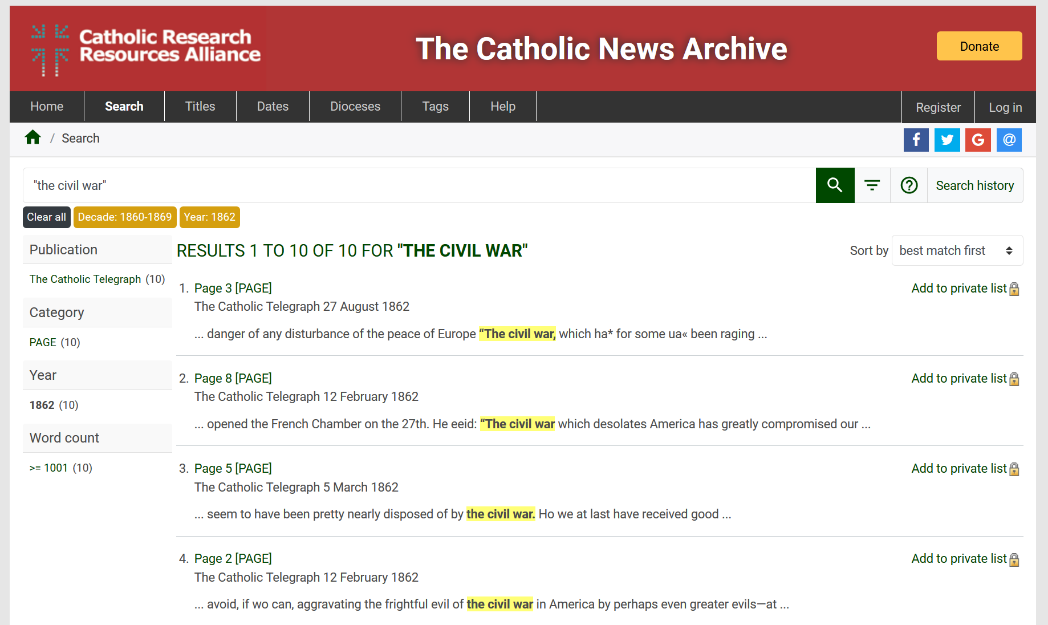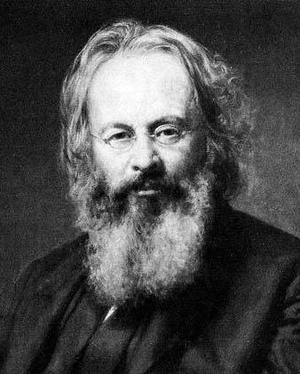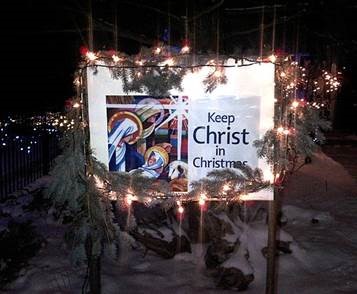In The Archivist's Nook, Dr. Maria Mazzenga, Catholic University, describes the evolution of the national Catholic press from its beginning in 1911 to its current global presence in over 200 American Catholic newspapers radio and video broadcasters as well as news broadcasters in over 60 countries. Read more
Search the Catholic Portal
Getting the Word Out: Whenever Possible Tell Scholars About the Trove That is The Catholic News Archive
 Masthead of Catholic Weekly “intended to contain” among other things “information of occurrences connected with the catholic [sic] religion in the United States, and various parts of Europe”
Masthead of Catholic Weekly “intended to contain” among other things “information of occurrences connected with the catholic [sic] religion in the United States, and various parts of Europe”
In the early 1840s reactionary agitators called Nativists whipped up Anti-Catholic/Anti-Immigrant fervor that resulted in armed conflict and the destruction of property in the city of Philadelphia, Pennsylvania. After the first Nativist Riot May 3-10, 1844, a public meeting of Philadelphia’s Catholic citizens appointed a committee to prepare an address to answer the accusations of a Grand Jury which blamed Catholics for the conflagration. The American patriotism of Catholics, namely their dedication to the protections guaranteed by the U.S. Constitution to minority groups, was one of the major points of the address.
Read More
The Catholic News Archive continues to grow in a consistent, healthy way. In March, 5,338 users visited the site for a total of 26.015 pages views. Please see the charts to get a sense of our strong growth trends.
Read More
- Catholic responses to slavery,
- Higher education and the American Civil War,
- Catholic responses to the Civil War,
- The experiences of rural Catholic communities, and
- Catholic seminary life

From the perspective of the professor, the students’ papers were greatly strengthened by the use of primary sources found in the Catholic News Archive. The students were able to integrate the sources in a way that strengthened their theses and conveyed their understanding of attitudes and opinions at the time of publication.
Two students commented to me that they have already thought of ways that they will use the resources of the Catholic News Archive to assist them in other courses.
A new way to explore the newspaper of the Catholic Worker movement started by Dorothy Day
 gh she was publicly acknowledged by Pope Francis as a great American during his 2015 speech before Congress, too many have heard too little about Dorothy Day. She was the co-founder of a movement that has produced Catholic Worker communities, “committed to nonviolence, voluntary poverty, prayer, and hospitality for the homeless, exiled, hungry, and forsaken.” The organ of the movement since its inception in 1933 is The Catholic Worker newspaper. As their Website goes on to say, “Catholic Workers continue to protest injustice, war, racism, and violence of all forms” (www.catholicworker.org).
gh she was publicly acknowledged by Pope Francis as a great American during his 2015 speech before Congress, too many have heard too little about Dorothy Day. She was the co-founder of a movement that has produced Catholic Worker communities, “committed to nonviolence, voluntary poverty, prayer, and hospitality for the homeless, exiled, hungry, and forsaken.” The organ of the movement since its inception in 1933 is The Catholic Worker newspaper. As their Website goes on to say, “Catholic Workers continue to protest injustice, war, racism, and violence of all forms” (www.catholicworker.org).What’s exciting is that an open digital archive of The Catholic Worker (1943 – 2016) has just become available, with promise of the first decade being added soon. Nonetheless, these digitized primary sources at thecatholicnewsarchive.org already give a unique and invaluable view on current world events from World War II to the early twenty-first century.
Special collections and archives existed long before we had computers. How did people find out about them in those dark decades of the twentieth century? Repositories often sent descriptions to the National Union Catalog of Manuscript Collections, managed by the Library of Congress. These collection-level descriptions appeared in bound volumes and on cards for the catalog.
In the 1960s, if you had an interest in one of the writers associated with the New England Transcendentalists, specifically Orestes A. Brownson who  later became a Catholic, you could check the NUCMC and find that Notre Dame has his papers and published a microfilm edition of them. If you were flipping through Notre Dame's card catalog looking for books by Brownson, you would discover that we also have his papers.
later became a Catholic, you could check the NUCMC and find that Notre Dame has his papers and published a microfilm edition of them. If you were flipping through Notre Dame's card catalog looking for books by Brownson, you would discover that we also have his papers.
Read More
A link to the new flier, A Fully-searchable open digital repository of historical Catholic news, is on the home page of the Catholic Newspapers Program. Scroll down to find the link to this downloadable, printable flier. This flier was distributed to attendees at the American Catholic Historical Association 2019 Annual Meeting in Chicago. Following a brief description, the focus is on what scholars, librarians and archivists say about their interests and use of Catholic newspapers.
Please share the flier with colleagues. And, use it in promotion to faculty and students, especially those engaged in historical research on a broad range of disciplines and topics such as school desegregation, peace, health care, and the Second Vatican Council. Content includes:
Read More
When Did American Catholics Start Asking to Keep Christ in Christmas?
While the concept to keep Christ in Christmas is not an exclusively Catholic theme it was interesting to discover by using the Catholic News Archive when the slogan started being promoted in earnest by Catholics in the United States. It seems it became a rallying cry after the Second World War. The National Catholic Welfare Conference News Service was the source that was later to become known as Catholic News Service Newsfeeds. They record in December 1949 an editorial entitled “Unholy Fraud” had caught widespread attention. 
![]()
Read More
Beginners' Bad Luck with EAD
As a former beginner myself, I recognize that the desire to produce EAD finding aids does not immediately result in their production. Among the members of CRRA, the more prosperous institutions can support compute r systems that automatically generate EAD. But even these systems require an understanding of archival theory and how it might be maintained in a way congenial to machines. And other members of CRRA have the more difficult task of producing EAD without sophisticated equipment and IT support.
r systems that automatically generate EAD. But even these systems require an understanding of archival theory and how it might be maintained in a way congenial to machines. And other members of CRRA have the more difficult task of producing EAD without sophisticated equipment and IT support.
CRRA developed the EAD Template to help those who have no easy way to produce valid finding aids. While it tries to make EAD as easy as possible, beginners may still have bad luck with it. When I attended the Rare Book School EAD course at the University of Virginia in 1999, I had already produced hundreds of EAD finding aids. Daniel Pitti, the teacher of the course, offered helpful criticism and mentioned several mistaken ways of thinking that he had found among beginners. When CRRA members started using the EAD Template, I found one of these typical mistakes cropping up.
 Archivists preserve filing systems that grow organically as routine activities generate records. The context of a document has evidential value; the whole filing system provides evidence about how an organization or individual conducted business, and therefore evidence of values, crises, attacks, defense mechanisms, unexpected events, daily life. Descriptions of such filing systems need to represent the organic form faithfully in all of its meaningful structure and peculiar quirkiness. Since filing systems generally have a hierarchical form, finding aids must also allow for components that contain other components that may contain other components -- boxes within boxes within boxes, or files within files within files.
Archivists preserve filing systems that grow organically as routine activities generate records. The context of a document has evidential value; the whole filing system provides evidence about how an organization or individual conducted business, and therefore evidence of values, crises, attacks, defense mechanisms, unexpected events, daily life. Descriptions of such filing systems need to represent the organic form faithfully in all of its meaningful structure and peculiar quirkiness. Since filing systems generally have a hierarchical form, finding aids must also allow for components that contain other components that may contain other components -- boxes within boxes within boxes, or files within files within files.
Thanks to our familiarity with common filing systems on computers, we should have no trouble with this concept. Typically graphical displays of the contents of a hard drive show pictures of folders, and inside them other folders, and after a number of these eventually the individual computer files. One can generally also choose to view the same structure as an outline representing this structure in a slightly different way.
Read More
CRRA Wins Catholic Communications Campaign Grant to Digitize Catholic News Service Newsfeeds
The Catholic Research Resources Alliance (CRRA) has won a $49,764 Catholic Communications Campaign grant from the United States Conference of Catholic Bishops (USCCB) for Preservation and Online Access to Catholic History -- NCWC/CNS 1920- . Funds will support the digitization and preservation of newsfeeds from the National Catholic Welfare Council (NCWC), currently known as the Catholic News Service (CNS) newsfeeds (the Catholic equivalent of Reuters).
100,000 pages of the NCWC/CNS newsfeeds from 1920- (approximately 30 years) will be digitized and made freely available through the CRRA-developed Catholic News Archive , a digital collection of Catholic diocesan and national newspapers. The newsfeeds will be digitized at the highest quality standards and the resulting digital images will be preserved in perpetuity.
Read More
Limit to full text in VuFind
This posting outlines how a "limit to full text" functionality was implemented in the "Catholic Portal's" version of VuFind.
While there are many dimensions of the Catholic Portal, one of its primary components is a sort of union catalog of rare and infrequently held materials of a Catholic nature. This union catalog is comprised of metadata from MARC records, EAD files, and OAI-PMH data repositories. Some of the MARC records include URLs in 856$u fields. These URLs point to PDF files that have been processed with OCR. The Portal's indexer has been configured to harvest the PDF documents, when it comes across them. Once harvested the OCR is extracted from the PDF file, and the resulting text is added to the underlying Solr index. The values of the URLs are saved to the Solr index as well. Almost by definition, all of the OAI-PMH content indexed by Portal is full text; almost all of the OAI-PMH content includes pointers to images or PDF documents.
Read More
CRRA Update Spring 2016
CRRA Update Spring 2016
(December, January, February)
Please see the PDF for the more visually rich version.
Read More
This blog posting outlines, describes, and demonstrates how a set of Catholic pamphlets were digitized, indexed, and made accessible through the Catholic Portal. In the end it advocates an evolution in librarianship.
A few years ago, a fledgling Catholic pamphlets digitization process was embarked upon. [1] In summary, a number of different library departments were brought together, a workflow was discussed, timelines were constructed, and in the end approximately one third of the collection was digitized. The MARC records pointing to the physical manifestations of the pamphlets were enhanced with URLs pointing to their digital surrogates and made accessible through the library catalog. [2] These records were also denoted as being destined for the Catholic Portal by adding a value of CRRA to a local note. Consequently, each of the Catholic Pamphlet records also made their way to the Portal. [3]
Read More
Kyle Roberts, Loyola University Chicago
The Jesuit Libraries Provenance Project (JLPP) was launched in March 2014 to create a visual archive of provenance marks from historic Jesuit college, seminary, and university library collections and to foster a participatory community interested in the history of these books.
Read More
CRRA Update Winter 2016
CRRA Update Winter 2016
(December, January, February)
Please see the PDF for the more visually rich version.
Feature Article: Interview with Michael Skaggs
From the Board
Committee Briefs
Read More
Interview with Michael Skaggs
Michael Skaggs is a doctoral candidate in the Department of History at the University of Notre Dame. He studies religion in the American Midwest, and is particularly interested in how interfaith organizations addressed social problems.
What is your current area of research?
Read More
The primary purpose of this posting is to document some of my experiences with OAI and VuFind. Specifically it outlines a sort of "recipe" I use to import OAI content into the "Catholic Portal". The recipe includes a set of "ingredients", site-specific commands. Towards the end, I ruminate on the use of OAI and Dublin Core for the sharing of metadata.

Read More
CRRA Update Fall 2015
CRRA Update
Fall 2015
(September, October, November)
please see the PDF for the more visually rich version
Read More
Jim McCartin, Associate Professor of Theology and Director of the Center on Religion and Culture at Fordham University, joins us for a discussion of his research and the role CRRA has played in shaping and abetting his scholarly work. His book, Prayers of the Faithful: The Shifting Spiritual Life of American Catholics, came out in 2010 and explores prayer in the lives of American Catholics from the 1860s to the 1980s. His current project is the book: American Catholics and Sex from the 1830s to the 1980s.
What is your current area of research?
Read More
CRRA Update Winter 2015
CRRA Update
Winter 2015
(December, January, February)
please see the PDF for the more visually rich version
In this issue:
